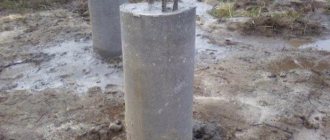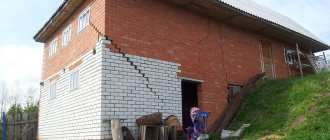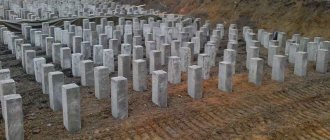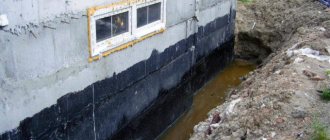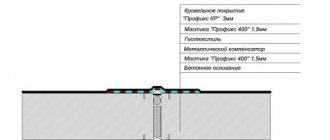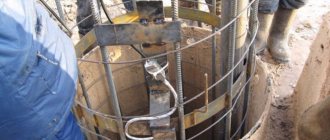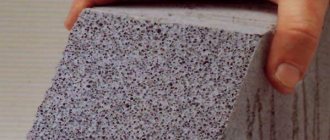When constructing a pile foundation, special attention should be paid to the piles used. Specifically, a house pile is a foundation support placed in the ground to transfer the building load to the ground. As a rule, piles are completely different in their characteristics. As a result, for building a house it is very important to choose the type of piles suitable for construction. In this article we will look at foundation piles and their types.
Piles for the foundation. Driving piles.
In essence, this classification feature helps determine the method of driving piles into the ground.
1. Driven piles. As you know, they are manufactured at the factory, most often in the form of reinforced concrete structures. In particular, the supports have a high load-bearing capacity and are capable of diving to a depth of up to 20 meters. However, special equipment is needed to immerse them. Moreover, by immersing the piles into the ground, the possibility of their deflection during operation is eliminated. Such piles are perfect for houses with a large mass and any number of floors.
2. Bored piles . As a rule, they are made directly in the place where the house is being built. In general, to install them, you need to drill and reinforce wells, and then fill them with concrete. This type of piles is mainly suitable for light houses.
3. Screw piles. In particular, they have a steel spiral wound onto their shaft. As it turned out, they are used in individual construction. Because it has to do with their length. The length of screw piles does not exceed 6 meters. Which, in turn, affects the load-bearing capacity of the piles. Such supports are widely used in the construction of frame houses, as well as houses made of timber, aerated concrete and foam blocks. Their main advantage is the ability to screw them into the ground yourself.
Types of piles according to the method of immersion in the ground. Clickable.
Pile foundation: types, advantages and disadvantages
The main elements of the foundation are piles, which have the shape of pillars or rods. The cross-section of products can be round or square. The supports are buried at a certain angle of inclination or strictly vertically. The technology for constructing pile foundations is quite simple. The choice of base design depends on various factors:
- type of piles and depth of their installation;
- soil structures;
- such as grillages, etc.
Piles
The procedure for installing supports is regulated by SNiP 2.02.03-85 . Most often, they are used for the construction of frame, panel and wooden low-rise buildings. When constructing multi-story buildings, the foundation is made of reinforced concrete piles. Houses built using pile technology do not have basements.
Construction of a pile-screw foundation
Table 1. Advantages and disadvantages of a pile foundation.
| Advantages | Flaws |
| Possibility of installation on difficult soils and mountainous terrain | Construction of the foundation requires special equipment |
| Foundation installation can be carried out in any weather | Pile foundations are not recommended for the construction of houses on horizontally moving soils |
| Minimum draft | Difficulties in constructing basement floors |
| Cost-effective and reliable | Inability to check installed piles for damage |
Video - Pros and cons of a pile foundation
Types of pile foundations
The classification of supports and foundations built with their help is carried out according to various criteria. According to the type of material used for their manufacture, piles are distinguished:
- wooden;
- concrete and reinforced concrete;
- metal;
- combined.
The most reliable structures are those consisting of combined supports. They retain their primary performance characteristics the longest. Wooden piles have the least strength and durability. Most of it is made from coniferous wood. Metal screw supports are made of ferrous metal. Before installation in the ground, the surface of wooden and metal piles is treated with special means.
Wooden piles
According to load-bearing loads, piles are distinguished:
- Racks. Completely transfer the load of the structure to the ground.
- Hanging piles . The load is transmitted by the side faces.
Based on the method of immersing supports in the ground, foundations are divided into:
- driving;
- drilling:
- screw;
- bored;
- combined.
Interesting! Pile foundations can withstand seismic loads up to 7 points . For their installation, not only supports produced in the factory are used. Bored rods are poured with concrete at the base site.
Driving concrete rods with a hydraulic hammer
Driven foundations
Driving technology is used in the construction of multi-story buildings. For the installation of their structures, rods made of reinforced concrete are used. In low-rise construction, it is permissible to use this technology for the construction of wooden and metal supports. Most often, they have a square cross-section with side sizes from 150 to 500 mm . Standard support lengths range from 3 to 25 m . Their lower end is sharpened. This greatly simplifies the process of driving piles into the ground.
Pile classification
The upper part of the supports is equipped with a head. It absorbs the hammer blow when hammering in products and protects them from deformation. The choice of piles depends on the properties of the soil and the design of the building being constructed. They are immersed in the ground until it stops in a solid earthen layer. This ensures the strength of the structure and does not allow the base of the buildings to “float”.
The advantages and disadvantages of driven foundations depend on the type of piles used to construct the structure. Among the advantages common to all types of supports:
- high structural strength;
- no need for preliminary preparation of the construction site;
- Possibility of installation in flooded areas.
Driving reinforced concrete piles
When constructing a pile foundation, the soil is not loosened, but compacted. Among the main disadvantages of driven structures:
- insufficient reliability when installed on swelling and subsiding soils;
- uneven shrinkage on soils with different densities.
Bored pile foundations
The technology is used for the construction of structures on plastically frozen and hard frozen soil. Work on installation of the base is carried out at a temperature not lower than 0.5°C . The work technology involves installing rods in pre-drilled wells. Their diameter should exceed the cross-section of the piles by 50-100 mm . Soil drilling is carried out using special equipment.
Important! 10 cm greater than the width of the support . After installing the rod in the well, the voids in it are filled with binding solutions. They increase the stability of the structure.
Drilling wells for piles
Pile-screw foundations
The technology is used in the construction of light and medium-sized buildings on all types of soil. In frequently flooded areas, this is the only possible way to build houses. The installation of screw foundations for various types of buildings was invented in the 19th century . It is widely used in the construction of piers and houses on the water.
Construction using screw technology can be carried out at any time of the year. To install the structure, metal piles with different numbers of blades are used. To immerse them in the ground, no special equipment is required. The piles are screwed into the ground by hand. The main advantages of the technology are the speed of installation and minimal costs for constructing the base.
Screw metal piles
Bored piles
Bored technology is used in the construction of heavy buildings on soft soils. When driving piles using this method, there is no vibration effect on nearby buildings. It is also possible to build objects using drilled technology in areas with difficult terrain. The requirements for these types of grounds are defined in the Code of Rules SP 50-102-2003 . The construction of foundations is carried out using:
- auger with a cavity for supplying concrete into the well.
- casing pipe with a vibrating hammer.
Foundation piles are poured with concrete directly into wells prepared for them. The technology can be used on hollow soils. Before pouring concrete into the well, reinforcement is made in it and its walls are strengthened from falling into the ground. Bored technology for constructing pile foundations is considered the most complex.
Bored piles
Combined foundation
Piles and slabs are used in foundation construction. Foundations of this type are erected on subsidence soils in accordance with Code of Practice 22.13330 . A distinctive feature of the design is the complete support of the slab on the ground. The grillage does not come into contact with the ground.
Pile combined foundation
Classification of foundations according to the nature of pile placement
The arrangement of piles in the ground is determined by the configuration of the building being constructed. Based on the method of their placement, structures are distinguished:
- Single piles . They are used in the construction of light agricultural buildings.
- Pile bushes . Columns are installed to carry large vertical loads.
- Continuous pile fields . The base is used for the construction of tower-type buildings.
- Strip pile foundations. Designed to support the walls of buildings.
Pile technology. Types of piles.
This classification helps to indicate the appearance of the pile.
1. Support piles . They have a smooth finish and a wide base. In short, such piles are used in cases where there is solid soil under loose layers of earth. Undoubtedly, the main function of support piles is to transfer the load of the house to the foundation. These piles also have a second name - rack piles.
2. Hanging piles. They have a corrugated coating, thanks to which they grip the ground. In turn, the piles transfer the load of the house to the soil. As it turned out, such supports are used in the presence of low groundwater levels. And also in the event that strong soil is located far away and deep construction work is ineffective. The second name for such piles is friction piles.
Classification of piles by appearance. Clickable.
Classification of grillages
When arranging pile foundations, different types of grillages are used in order to optimally reduce the cost of work and not reduce the functionality of the foundation.
Classification of pile foundation grillages:
- strip - a beam laid around the perimeter of the object and under the walls;
- slab – represented by a slab, used if pile supports are placed over the entire area of the object.
In addition, the following types of grillages are distinguished:
- prefabricated - wood, reinforced concrete beams, metal profile;
- prefabricated monolithic - installation is carried out from reinforced concrete elements with special locks. The final stage of assembly is considered to be embedding;
- monolithic - production is carried out on the construction site by pouring mortar into the formwork.
Piles for the foundation. Pile material.
1. Reinforced concrete piles. A distinctive feature of these piles is their long service life (up to 100 years). As a rule, such piles can be manufactured both at the factory and at the site where the house is built. The second option is typical for individual construction. Because there is no need to use expensive equipment. To facilitate installation, reinforced concrete piles can be equipped with a screw.
2. Steel piles. Made from pipe or profile. They have a wall thickness of 8 to 12 mm. There are different options for steel piles. For example, box-section piles, I-beam supports, etc. In order to strengthen the steel pile, it is equipped with a tip, which is welded down the supports.
However, due to corrosion, steel piles should be provided with additional protection. For this, various special compositions are used. For example, it could be bitumen or coal tar. These piles have not found widespread use. This is due to a number of reasons:
— due to their large weight, it is necessary to use a crane for installation;
— significant consumption of metal;
- need for processing.
3. Wooden piles. Made from hard coniferous trees. These are trees such as pine, spruce, etc. The length of wooden piles usually does not exceed 8.5 m.p., and their diameter is 220-340 mm. Currently, such piles are used very rarely. This is due to the fact that they are susceptible to rotting.
Types of piles by type of material. Clickable.
Installation of piles. Types of piles.
This classification allows you to calculate the number of piles and determine the location for their installation.
1. Piles formed into pile strips . Each strip may include one or two rows of piles. Their main function is to transfer the load of the house to a solid foundation.
2. Free-standing piles. This means that the support is located under the separately placed elements. For example, under the columns of a room.
3. Piles formed into pile bushes. In this option, the piles are placed in groups. This installation method is used in the presence of loose soil or close groundwater. In most cases, pile bushes are formed in places with significant load. For example, entering a garage.
Types of piles according to placement method. Clickable.
Burying technology
Types of pile foundations are primarily distinguished depending on the technology of installation of pile supports. So, the following types of piles are distinguished:
- Screw - the support is screwed into the ground.
- Driven - piles are driven using special installations.
- Drilling - before installing supports, wells are drilled in the ground. Then they are reinforced and filled with mortar.
- Shell supports - a hollow pile is driven into the ground by a special vibrator. The soil is removed from the inside, and the void is filled with solution.
